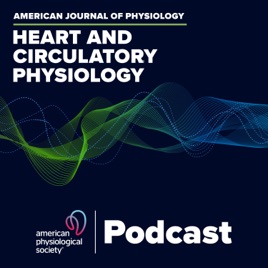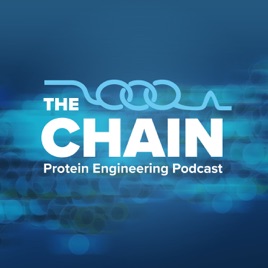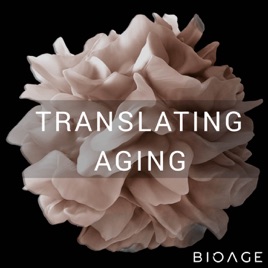
Advertise on podcast: AJP-Heart and Circulatory Physiology Podcast
Rating
4.4 from
Country
This podcast has
20 episodes
Language
Publisher
Explicit
No
Date created
2011/05/23
Average duration
32 min.
Release period
26 days
Description
Insightful author interviews about innovative research published in AJP-Heart and Circulatory Physiology
Podcast episodes
Check latest episodes from AJP-Heart and Circulatory Physiology Podcast podcast
Impact of Maternal Diet on Offspring Blood Flow
2024/01/12
What is the relationship between cardiovascular developmental programming and the risk of stroke later in life? Listen as Guest Editor Dr. Helen E. Collins (University of Louisville) interviews author Dr. Nafisa Jadavji (Midwestern University) and expert Dr. Deanne Hryciw (Griffith University) about the latest research by Pull et al. looking at underlying mechanisms associated with a poor-quality diet during pregnancy. One-carbon metabolism is essential for biosynthesis of DNA and proteins, as well as methylation. Jadavji and co-authors demonstrated that maternal dietary deficiency in one-carbon (1C) metabolism, either in folic acid or choline, resulted in reduced cerebral blood flow in adult offspring after an ischemic stroke. Pull et al. focused their investigation on female offspring and identified this effect in 3-month-old offspring but not 11-month-old offspring. The results point to the key role that maternal diet has in early life programming, fetal development, and long-term cerebrovascular health. Are there many downstream pathways that are altered by one-carbon metabolism deficiencies? Is there a negative impact of folic acid over-supplementation? Listen now to find out.
Kasey Pull, Robert Folk, Jeemin Kang, Shaley Jackson, Brikena Gusek, Mitra Esfandiarei, and Nafisa M. Jadavji Impact of maternal dietary folic acid or choline dietary deficiencies on vascular function in young and middle-aged female mouse offspring after ischemic stroke Am J Physiol Heart Circ Physiol, published October 30, 2023. DOI: 10.1152/ajpheart.00502.2023
more
Cardiac Sex Differences and COVID
2023/12/07
Given that there appears to be variation in significant risk to the cardiovascular system following SARS-CoV2 infection with regard to age and sex, the latest study by Rouhana et al. provides a foundation for studying sex differences with a preclinical model of infection to the direct exposure to SARS-CoV-2 and the impact on the myocardium of ferrets. Listen as Associate Editor Dr. Keith Brunt (Dalhousie University) interviews authors Dr. Alyson Kelvin (University of Saskatchewan) and Dr. Glen Pyle (University of Guelph) along with expert Dr. Susan Cheng (Cedars-Sinai Smidt Heart Institute). The authors identified that phosphokinase expression, normally associated with cardiac stress remodeling, is distinct by time and sex effects. Additionally, the authors found that inflammatory patterns of macrophage markers showed inherent sex differences in immune responses at the level of the myocardium. Why are ferrets a such a useful preclinical model for understanding SARS-CoV2 infection? How do immune inflammatory responses differ by sex, timing, and age? As Dr. Brunt points out, “There is power in observation, collaboration, and when it comes to bugs and bodies…it’s physiology.” Read the paper, listen to this podcast, and find out more.
Sarah Rouhana, Kathy Jacyniak, Magen E. Francis, Darryl Falzarano, Alyson A. Kelvin, W. Glen Pyle Sex differences in the cardiac stress response following SARS-CoV-2 infection of ferrets Am J Physiol Heart Circ Physiol, published October 18, 2023. DOI: 10.1152/ajpheart.00101.2023
more
Preload and Calcium Handling in Muscular Dystrophy
2023/11/28
What does a mouse heart have to do with an M&M candy (the regular kind, not the peanut variety)? In our latest episode, Associate Editor Dr. Crystal Ripplinger (University of California, Davis) interviews author Dr. Tim Domeier (University of Missouri) and expert Dr. DeWayne Townsend (University of Minnesota) about the recent study by Haffner et al et al. The authors examined cardiac calcium mishandling and damage in the setting of Duchenne muscular dystrophy (DMD). Using a genetic mouse model of DMD crossed with a mouse that expresses a genetically encoded calcium indicator, Domeier and colleagues investigated changes in intracellular calcium handling in response to increased preload. The unexpected finding was that after the acute preload challenge, many of the cells were missing-in-action. What was going on with these missing cells? Listen as we talk about how individual dystrophic cells blow up if stretched too far, and why pointing microscopes in different directions might be the next step to overcome optical imaging challenges. Don’t miss this episode – the enthusiasm for science, tiny pumping mouse hearts, and squishy cells is contagious!
Vivian Haffner, Zahra Nourian, Erika M. Boerman, Michelle D. Lambert, Laurin M. Hanft, Maike Krenz, Christopher P. Baines, Dongsheng Duan, Kerry S. McDonald, Timothy L. Domeier Calcium handling dysfunction and cardiac damage following acute ventricular preload challenge in the dystrophin-deficient mouse heart Am J Physiol Heart Circ Physiol, published October 18, 2023. DOI: 10.1152/ajpheart.00265.2023
more
Coronary Endothelial Function, HIV, and Aging
2023/11/08
People living with HIV have an increased risk of developing cardiovascular disease, including coronary artery disease. Until now, it has been unclear why. In this episode, Guest Editor Dr. Ashley Walker (University of Oregon) interviews author Dr. Efthymios Ziogos (Johns Hopkins Medicine) and expert Dr. Jennifer Williams (McMaster University) about the recent study by Ziogos et al. published in the Call for Papers Impact of Aging on CV System. Ziogos and co-authors used advanced MRI to assess coronary endothelial function noninvasively and without contrast in order to compare endothelial-dependent vasoreactive responses in coronary arteries to isometric handgrip exercise, both in people living with HIV and HIV negative individuals. The authors found that coronary endothelial function was impaired in people living with HIV, compared to HIV negative individuals. While it is known that there is a negative correlation between age and coronary endothelial function in HIV negative individuals, the authors found no correlation between age and endothelial function in HIV positive individuals, suggesting early vascular aging in individuals with HIV. This study is truly an example of an important research question that went unaddressed until recently because of the need for the advanced measurement techniques used by Ziogos and collaborators. While there is still much to learn about HIV, this research offers new insights into the potential causes of increased coronary artery disease in people living with HIV, and provides new avenues for preventive cardiology research in this population. Listen now to find out more.
Efthymios Ziogos, Yaa A. Kwapong, Robert G. Weiss, Michael Schär, Todd T. Brown, Shashwatee Bagchi, Alborz Soleimanifard, Tarek Harb, Damani A. Piggott, Gary Gerstenblith, Thorsten M. Leucker, Allison G. Hays Coronary Artery Endothelial Function and Aging in People with HIV and HIV-Negative Individuals Am J Physiol Heart Circ Physiol, published October 9, 2023. DOI: 10.1152/ajpheart.00143.2023
more
Estimating Cardiac Output During Incremental Exercise
2023/10/02
What does it sound like when a young researcher meets one of his science heroes for the first time? Listen to this episode of The AJP-Heart and Circ Podcast to find out. Associate Editor Dr. Keith Brunt (Dalhousie University) interviews author Dr. Holger Burchert (University of Basel) and leading expert Dr. William Stringer (Lundquist Institute at Harbor-UCLA Medical Center) about a new Methods and Resources article published by Burchert and Klimpel as part of the recent Call for Papers on Exercise, Physical Activity, and Cardiovascular Health. The article by Burchert et al. is an important contribution of methodological advancement built upon a foundation of established literature, dating back to Fick’s Principle, which first appeared as a two-paragraph conference abstract published in German in 1870 and later translated by The New England Journal of Medicine in 1948. Fick was the first to realize that cardiac output is equal to oxygen consumption divided by the arterial mixed venous oxygen content difference, allowing the first accurate determination of cardiac output. While non-invasive measurements of oxygen consumption and heart rate are now routine, sampling arterial and mixed venous blood is inherently challenging. This makes finding non-invasive techniques for these measurements incredibly important. Enter the OG of the linear method for determining the arterial mixed venous oxygen content difference, Dr. William Stringer. In his seminal 1997 article published in the Journal of Applied Physiology, “Cardiac output estimated noninvasively from oxygen uptake during exercise”, Dr. Stringer found that the arterial mixed venous oxygen content difference during incremental exercise can be estimated because it behaves in a predictable, linear fashion, thus avoiding the difficult blood sampling. Reading the article by Stringer et al., which was referenced in the CPET (cardiopulmonary exercise testing) machine manual Burchert used during his PhD work, sparked Burchert’s interest to investigate the literature and ultimately build on Stringer’s methodological approach by collaborating with this former school friend Dr. Fabian Klimpel. Burchert et al. found that a 3rd order polynomial S-curve described the arterial mixed venous oxygen content difference slightly better. More importantly, the authors also determined that the inflection point of this function could be related to the first ventilatory threshold and the inflection point of the oxygen dissociation curve. Why is this important? A deeper understanding of the mechanisms behind the s-shaped response has potential clinical translation, as the method could be further developed by tailoring it to individual patients. Listen as we discuss why it is important for early career researchers “to look back in order to look forward,” to use collaborators from other disciplines to support thinking creatively about cardiovascular physiology, and to align with mentors who facilitate young careers through constructive peer review and publication.
Holger Burchert and Fabian Klimpel Revisiting cardiac output estimated noninvasively from oxygen uptake during exercise: an exploratory hypothesis-generating replication study Am J Physiol Heart Circ Physiol, published August 25, 2023. DOI: 10.1152/ajpheart.00330.2023
William W. Stringer, James E. Hansen, and K. Wasserman Cardiac output estimated noninvasively from oxygen uptake during exercise J Appl Physiol, published March 1, 1997. DOI: 10.1152/jappl.1997.82.3.908
Fick, A On the Measurement of the Blood Quantum in the Ventricles of the Heart. Bauhaus-Universität Weimar, 1870, p. 16.
more
Hot Yoga and Sodium-Induced Endothelial Dysfunction
2023/08/10
Come for the yoga metaphors, stay for the science. In this episode, Associate Editor Dr. Keith Brunt (Dalhousie University) interviews author Dr. Stacy Hunter (Texas State University) and expert Dr. Annet Kirabo (Vanderbilt University) about the new study by Hunter et al., which examined the impact of hot yoga on sodium-induced pressor responses and endothelial function of Black women. In a randomized control trial that combined the thermal stress of hot yoga and a salt challenge, the authors investigated human homeostatic regulation in terms of whole-body physiology, cardiorenal responses, physical activity, and the exercise environment. In their study, Hunter and collaborators controlled for sodium intake by separating participants into high and low sodium groups, with pre and post analyses of body mass, ambulatory blood pressure, urinalysis, and flow mediated dilation. The authors found that participants who actively engaged in hot yoga showed increased flow mediated dilation but not increased blood pressure. Why did the authors use a 3-day, not 5-day, hot yoga exercise protocol? What insights can be gained about salt-sensitivity in Black women from this study, which incorporated a form of exercise that activated both thermoregulation and the parasympathetic nervous system? Listen to find out.
Stacy D. Hunter, Stavros A. Kavouras, and Mitra Rahimi Exploring heated exercise as a means of preventing the deleterious effects of high-sodium intake in Black women Am J Physiol Heart Circ Physiol, published May 4, 2023. DOI: 10.1152/ajpheart.00699.2022
more
Soluble Prorenin Receptor and Vascular Damage
2023/07/31
What is the impact of female sex hormones on obesity, diabetes, and vascular dysfunction? In this episode, Deputy Editor Dr. Zam Kassiri (University of Alberta) interviews authors Dr. Bruna Visniauskas and Dr. Minolfa Prieto (both at Tulane University School of Medicine), along with expert Dr. Glen Pyle (IMPART Network at Dalhousie Medicine) about the new study by Visniauskas et al. Using a long-term high fat diet mouse model of type 2 diabetes, the authors found that male mice had higher increases in plasma levels of prorenin and renin soluble prorenin receptor and angiotensin 2, which was also associated with hypertension and carotid artery stiffness, compared to female mice. This led Visniauskas et al. to interrogate a potential causal role of soluble prorenin receptor in development of the diabetes phenotype in the mice fed the high fat diet. Since female mice were less prone to the diabetic phenotype than males, the authors ovariectomized female mice to interrogate the role of estrogen in the development of the diabetes phenotype. Prieto, Visniauskas, and co-authors observed the Type 2 diabetes phenotype in both males and ovariectomized females but not intact females. How does dipping vs. non-dipping hypertension factor in? Will the soluble prorenin receptor emerge as a more reliable biomarker for vascular pathologies related to diabetes? Listen and find out.
Bruna Visniauskas, Virginia Reverte, Caleb M. Abshire, Benard O. Ogola, Carla B. Rosales, Michelle Galeas-Pena, Venkata N. Sure, Siva S. V. P. Sakamuri, Nicholas R. Harris, Isabella Kilanowski-Doroh, Alexandra B. Mcnally, Alec C. Horton, Margaret Zimmerman, Prasad V. G. Katakam, Sarah H. Lindsey, and Minolfa C. Prieto High-plasma soluble prorenin receptor is associated with vascular damage in male, but not female, mice fed a high-fat diet Am J Physiol Heart Circ Physiol, published April 25, 2023. DOI: 10.1152/ajpheart.00638.2022
more
Pre-operative COVID19 and Cardiovascular Complications
2023/07/24
When is it safe to have surgery after COVID? Listen as Associate Editor Dr. Jason Carter (Baylor University) interviews lead author Dr. Anai Kothari (Medical College of Wisconsin) and leading expert Dr. Michael Joyner (Mayo Clinic) about the groundbreaking new research study by SenthilKumar et al. that evaluated how pre-operative COVID infection might affect a patient’s risk of post-operative major adverse cardiovascular and cerebrovascular events (MACE) by analyzing data from 457,804 patients within the National COVID Cohort Collaborative (N3C) Data Enclave. In fact, it was a surgical operation in October 2020 that inspired Dr. Kothari and collaborators to consider how the stress of surgery combined with the potential end-organ changes that happen with prior COVID infection would impact surgical outcomes. If patients had a prior history of COVID followed by a subsequent non-emergency surgery, the authors found a 12% increase in overall risk of having a major adverse cardiovascular or cerebrovascular event after surgery. The authors found that most patients had surgery more than 8 weeks after COVID infection. However, if patients had surgery in the first 4 weeks after COVID infection, there was a slight increase in the number of post-surgical MACE. Disease severity had a major impact on post-surgical incidence of MACE. In contrast, vaccination against COVID decreased the risk of MACE without increasing the risk of any post-operative negative outcomes that the group assessed. Listen as these experts discuss surgical timing and the role of COVID vaccines to not only reduce risk of post-surgical MACE for patients but also to protect immunocompromised individuals in the greater population.
Gopika SenthilKumar, Nathaniel B. Verhagen, Salma A. Sheriff, Xin Yang, Carlos E. Figueroa Castro, Aniko Szabo, Brad W. Taylor, Njeri Wainaina, Kathryn Lauer, Jon C. Gould, and Anai N. Kothari on behalf of the N3C Consortium Preoperative SARS-CoV-2 infection increases risk of early postoperative cardiovascular complications following noncardiac surgery Am J Physiol Heart Circ Physiol, published April 25, 2023. DOI: 10.1152/ajpheart.00097.2023
more
How the American Physiological Society can Promote Black Physiologists
2023/06/29
What does being a good ally look like? In a new Perspective, authors Dr. Karla Haack (Merck), Dr. Austin Robinson (Auburn University), Dr. Dexter Lee (Howard University College of Medicine), Dr. Keisa Mathis (University of North Texas Health Science Center), and Dr. Junie Paula Warrington (University of Mississippi Medical Center) discuss how the American Physiological Society (APS) can promote Black physiologists and support them in the challenges they face. The authors sat down with The AJP-Heart and Circ Podcast for a wide-ranging interview at the cross-section of social justice and science. The authors feel that APS has a unique opportunity as an international organization to be at the forefront of supporting Black physiologists and boosting the success of underrepresented minority APS members. As the authors note, Black students are often first-generation college students, and therefore mentoring and K-12 physiology outreach are critically important. Robinson et al. discuss issues around the underrepresentation of Black physiologists at the faculty level, as well as challenges with access to pilot funding to support Black early career researchers. The authors discuss many actionable steps, such as inviting Black physiologists to be scientific co-investigators and co-authors on studies, as well as partnering with Historically Black Colleges and Universities to help build a pipeline of future Black physiologists. The authors take-home message? Don’t underestimate the power of being an ally and using your voice to amplify the voices of Black physiologists. As Dr. Junie Paula Warrington stated, “One person at a time, we can make a huge impact.”
Austin T. Robinson, Nathaniel D. M. Jenkins, Sofia O. Sanchez, Karla K. V. Haack, Dexter L. Lee, Keisa W. Mathis, and Junie P. Warrington Supporting and promoting Black physiologists: how can the APS help? Am J Physiol Heart Circ Physiol, published May 4, 2023. DOI: 10.1152/ajpheart.00082.2023
more
Inclusive Demography in Medical Research
2023/06/27
How can researchers capture the most accurate demographic data possible on intake surveys for human participant studies? Listen as author and moderator Dr. Karla Haack (Merck) interviews co-authors Dr. Jesse Moreira (Boston University) and Dr. Troy Roepke (Rutgers, The State University of New Jersey) about their recent Perspective regarding how researchers can do inclusive and precise research with an open mindset in order to avoid excluding groups of people when developing survey demographic questions for human participant research studies. In their article, Moreira et al. offer actionable steps to develop inclusive survey language for the LGBTQIA2S+ community with precise science at the forefront. The goal is to increase participation among LGBTQIA2S+ people and collect demographic data in a manner that does not alienate or marginalize anyone who may already be experiencing marginalization. The authors make the case that researchers should not be afraid to be precise, and careful attention to language does not involve extra effort on the part of researchers. For example, researchers can include a semi-exhaustive list of gender along with a fill-in “I self-describe as" field. If researchers introduce themselves using their own preferred pronouns, the authors explained, and then ask what pronouns study participants prefer to use, it can make an enormous difference to the sense of belonging for potential study participants. Words help science to be more exact. Simply stated, words matter. Listen to learn more.
Jesse D. Moreira, Karla Haack, Vee White, Melissa L. Bates, Deepa M. Gopal, and Troy A. Roepke Importance of survey demographic questions to foster inclusion in medicine and research and reduce health inequities for LGBTQIA2S+ individuals Am J Physiol Heart Circ Physiol, published May 12, 2023. DOI: 10.1152/ajpheart.00152.2023
more
Efficacy of Growth Hormone-Releasing Hormone-Agonist in a Cardiometabolic HFpEF Model
2023/05/19
Heart failure with preserved ejection fraction (HFpEF) is, in many ways, a fascinating tale of modern cardiovascular medicine that, according to lead author Dr. Joshua Hare (University of Miami Miller School of Medicine), has taught cardiovascular researchers and clinicians a lot of humility. Understanding HFpEF in a variety of animal models has led to a paradigm shift away from heart failure linked to low ejection fraction. In this episode Associate Editor Dr. Jonathan Kirk (Loyola University Chicago Stritch School of Medicine) interviews Dr. Hare along with expert Dr. Julie McMullen (Baker Heart and Diabetes Institute, Melbourne, Australia) about the latest study by Kanashiro-Takeuchi et al. The Hare Lab was originally attracted to a cardiometabolic model of HFpEF pioneered by Dr. Joseph Hill, because in a large proportion of human patients, HFpEF is due to metabolic syndrome, which is a combination of obesity, diabetes, and hypertension. Armed with the ability to create this cardiometabolic HFpEF model, Hare and co-authors decided to test growth hormone-releasing hormone-agonist using a powerhouse of methods to determine if exercise intolerance could be improved. Kanashiro-Takeuchi et al. found that diastolic function and exercise performance improved, and myocyte hypertrophy and fibrosis were restored. Essentially all of the features of cardiometabolic HFpEF responded to treatment with GHRH-agonist. The authors did not see a reduction in blood pressure or weight, indicating a direct myocardial effect. In a wide-ranging discussion that touches on skeletal muscle, aging, sarcomeric proteins, and the technical complexities of running titin gels and PV loops, our experts explain why HFpEF is such a challenging syndrome to treat and why this translational research is so important. Listen now.
Rosemeire M. Kanashiro-Takeuchi, Lauro M. Takeuchi, Raul A. Dulce, Katarzyna Kazmierczak, Wayne Balkan, Renzhi Cai, Wei Sha, Andrew V. Schally, Joshua M. Hare Efficacy of a Growth Hormone-Releasing Hormone Agonist in a Murine Model of Cardiometabolic Heart Failure with Preserved Ejection Fraction Am J Physiol Heart Circ Physiol, published April 25, 2023. DOI: 10.1152/ajpheart.00601.2022.
more
LV Vortex Patterns Change from Newborns to Adults
2023/04/10
“You cannot make good predictions for patients until you understand the physiology,” stated Dr. Kristian Becker (Icahn School of Medicine at Mount Sinai). Becker and co-authors demonstrated for the first time echocardiographic evidence of a transition in the left ventricular vortex patterns of the heart from the newborn period to the adult period. Listen as Associate Editor Dr. Amanda LeBlanc (University of Louisville) interviews Dr. Becker and expert Dr. Ann Chiao (Oklahoma Medical Research Foundation) about how the authors used vector flow mapping to identify changes in cardiovascular efficiency, which were marked by increased energy loss during infancy. In this Rapid Report, which was published in the Call for Papers on the Impact of Aging in the Cardiovascular System, Becker and co-authors found that one early diastolic vortex in newborns transitions to two early diastolic vortices by 2 years of age. Vector flow mapping is an echocardiographic technique that combines doppler ultrasound and blood speckle tracking to follow the direction and velocity of blood in the heart. As a bridge between cardiac MRI and traditional ultrasound, vector flow mapping gives researchers and pediatric cardiologists an understanding of how blood is flowing in the heart and whether heart defects or cardiomyopathies affect blood flow. Given that the heart is a master adapter—it grows from about the size of a walnut at birth to the size of a peach in adulthood—mapping energy loss when the heart is transitioning in size and shape with age is critically important to clinicians. The authors want to take their research from bench to bedside, and back to the bench, for a complete understanding of the heart. Listen now to find out more.
Kristian C. Becker, Jennifer Cohen, Jon D. Nyce, Jen Lie Yau, Santosh C. Uppu, Partho P Sangupta, and Shubhika Srivastava Age Related Changes in Left Ventricular Vortex and Energy Loss Patterns: From Newborns to Adults Am J Physiol Heart Circ Physiol, published March 10, 2023. DOI: 10.1152/ajpheart.00002.2023
more
Podcast reviews
Read AJP-Heart and Circulatory Physiology Podcast podcast reviews
lilRauch
2021/01/15
Science Rocks!
I love this podcast! It helps us understand what the authors are thinking and why they did this project! I would love if they had more “behind the ben...
more
Podcast sponsorship advertising
Start advertising on AJP-Heart and Circulatory Physiology Podcast & sponsor relevant audience podcasts
You may also like these life sciences Podcasts

4.9
222
372
Qiological Podcast
Michael Max

4.7
14
61
The Chain: Protein Engineering Podcast
Cambridge Healthtech Institute

5
63
102
Real Science Exchange
Balchem Animal Nutrition & Health

0
0
83
BIOfunk - Der Biologie Podcast
BiOfunker

5
10
49
Translating Aging
BioAge Labs

4.4
9
20
AJP-Heart and Circulatory Physiology Podcast
American Physiological Society

4.7
22
242
Dog Cancer Answers
Dog Podcast Network

5
3
35
The Life Science Rundown
The FDA Group

4.5
41
958
Naked Scientists, In Short Special Editions Podcast
The Naked Scientists

4.8
15
146
Living Mirrors with Dr. James Cooke
Dr. James Cooke



